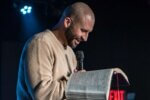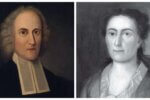Ministry isn’t easy on Native American reservations. Charisma visited one in Montana to see how the gospel is making a difference.
Tribal officer Stuart Gardner is surrounded by small children, angry women and gaunt dogs as he sorts out a problem in a decaying housing project. At stake is the custodial issue of a child in the house. “Another call for Family Services,” he says softly as he gets in his four-wheel-drive police vehicle and drives away.
Gardner’s jurisdiction is the 445,000-acre Northern Cheyenne Indian Reservation in south-central Montana. Of the tribe’s 6,479 members, 4,064 live on “The Rez.”
Gardner didn’t return here to be a cop. He wanted to be a pastor. For now, being a cop might be a higher calling. His main beat is Lame Deer–a community of 2,000 residents, many boarded-up businesses and one traffic light in the middle of Cheyenne country.
The Northern Cheyenne were once one of the most prosperous and feared of the Plains Indian tribes. They were hunters, horsemen and warriors.
Everything has changed now.
Gardner’s evening began with a call to the Cheyenne Depot, the tribally owned convenience store, where an argument between two women had become violent. Gardner took both women in, then responded westward to locate a suspected drunk driver. But the renegade vehicle escaped onto the neighboring Crow Indian Reservation.
The Crow Rez is five times larger than the Cheyenne, a dividend, perhaps, for being on Custer’s side at the Battle of the Little Big Horn. A year after that battle, 937 Cheyenne fled internment in the Indian Territory of Oklahoma and followed a bloodstained path back to these ancestral hunting grounds.
Gardner’s patrols are typical for law enforcement on the nation’s 326 reservations, where unemployment can exceed 80 percent, and alcoholism, drug use, teen pregnancy, suicide, child abuse and violent-crime rates are many times higher than the national average. Life expectancy is as low as 40 years for men.
Back in Lame Deer a small herd of horses are loose on Cheyenne Drive, the community’s main drag. Gardner helps two mounted boys direct the horses back to a corral near the Southern Baptist Church.
This is the church pastored by Dean and Keli Smith, who came here from Florida.
“We have just entered a Third World country,” Dean announced when they first crossed onto the Rez. They’d bucked the wishes of church leaders and family to come with their three daughters as lay volunteers in an alien land.
Within months the job as pastors was theirs by abdication, and they’ve since endured some storms. “I just hated it here the first year,” Keli says.
But they’ve survived, and now Dean says: “I love it here. I revel in it.”
At the traffic light Gardner turns east toward Ashland to stop a van suspected of containing alcohol. He pulls the vehicle over in front of the Charging Horse Casino, an imposing building from the outside. Inside, it contains a den of poker machines, a bingo hall and a small cafeteria.
According to the National Indian Gaming Association, more than 200 Indian tribes make use of gaming, an enterprise that creates 300,000 jobs nationwide. But because Lame Deer is bisected by only a two-lane highway, the town doesn’t have the tourist traffic to benefit from a gambling industry.
Lame Deer does have Dull Knife Memorial College, a two-year school. Gardner’s sister Wilma LaRance works there as the head accountant. LaRance and Gardner come from a large Cheyenne family whose real surname is Big Foot. The name change was a result of the federal government’s assimilation programs after World War II.
All eight Gardner children are tall, strong and athletic, and most are actively serving God. Their mother raised them with a Mennonite influence, and they also gleaned the best of the traditional aspects from their father. Stuart has, however, challenged his father over his native spirituality.
LaRance’s husband, Albert, 31, is not a Rez Indian but an urban mixed-blood. Raised in Sterling, Colorado, he became a Christian at Lakewood Church in Houston when it was pastored by John Osteen.
Albert and Wilma pastor the Morning Star House of Prayer. Albert balances being a full-time pastor with being a stay-at-home dad to their two small children.
The setting sun bathes pine-topped buttes in an orange glow as Gardner checks the reservation’s north entry. A stone’s throw away is the infamous Jim Town Bar that once boasted the largest pile of empty beer cans in the world. A few more miles down the road is Nick Golder’s ranch. Golder is Albert and Wilma’s mentor.
At 69, Golder is sinewy and somewhat irascible. For 30 years he has tried to ignite the innate spirituality within the Cheyenne people. “They’ve always seen into the spirit world,” he says of them. “They just need to know Jesus.”
Golder is a combat-weary veteran of spiritual warfare. As it has on many reservations, the Native American Church–also known as “the peyote church”–has a presence here. Golder says tribes also are turning increasingly to native religions and ceremonies including the Sun Dance and Ghost Dance.
“Sometimes that dang peyote drum beats all day and night,” Golder says. It’s legal for natives to use peyote, a natural hallucinogen, in religious ceremonies, but the cactus has to be imported from the Southwest. Rumors also abound on the Rez about “bad medicine”–the curses “traditional” Natives put on people by using ancient rituals for revenge.
Gardner heads back “downtown.” There used to be a golf course, movie theater, swimming pool and bowling alley in Lame Deer. They all are gone today. You can count the commercial buildings on one hand.
Gardner turns onto a graveled side street. In a lot across from the funeral home, workers are putting up a revival tent. This is Michelle Wilson’s doing. She’s a controversial Crow woman who split from a local Pentecostal assembly to start her own church that temporarily meets in the local mortuary.
Wilson is effervescent about her work here. “I sense a stirring in the land,” she says. “We are going to see altars to the Lord arise like never before. We Natives have an inheritance in this.”
By this she means revival, end-time harvest and the destiny of America’s indigenous people. Wilson’s revivals include business seminars because “the Cheyenne people have wrongly been taught that poverty is humility,” she says. Success in business is probably more alien to the Cheyenne than tent revivals.
Chahoristah Rowland, 20, wants to get a degree in business and run her own company some day. “The way it looks, I’m not going to make it,” she says.
Rowland is bright and ambitious–after two years of looking she found employment as a day-care worker at the college–but she stays too busy keeping younger members of her family out of trouble to concentrate on schooling.
“There is nothing to do here,” she says. “We used to have a softball field, but they built a clinic on it.”
Athletics are important on the Rez, especially basketball, but few native athletes go on to college ball. Clinics might be more important, though. Sugar diabetes, Fetal Alcohol Syndrome and other diseases are epidemic here.
There is no lack of churches on the reservation. Some were ushered in a century ago to “Christianize” natives through boarding schools–but Rowland says her age group finds church “stupid.” Traditional native religion, she admits, does interest her. Good jobs would interest her more.
A misconception common outside the Rez is that tribal members receive monthly federal stipends. Not so–just the usual welfare checks, plus subsidized housing and health care.
Ironically, the Northern Cheyenne sit on a vast supply of wealth. Coal mines surround the reservation and recent discoveries of coal-bed methane have the potential to make the Cheyenne prosperous, if not downright wealthy. But at what cost?
“We need to attract culturally accepted industry,” says Eugene Little Coyote, one of the younger members of the tribal council. That probably rules out coal or methane.
The Cheyenne fear large industry would plunder the land and culture, thus fulfilling the 18th century prophecies of their historic spiritual leader, Sweet Medicine. He predicted the white man’s invasion and warned that the Cheyenne would become “worse than crazy”–as Little Coyotes says–if they tore up the earth.
Little Coyote is educated and progressive, but he also represents the younger generation’s renewed interest in traditional ceremonies. When asked, he suggests he cannot talk about the Sun Dance with a non-Cheyenne.
The Sun Dance–outlawed by the federal government in 1904 but legalized under “special circumstances” in the 1970s–is a summer ceremony that involves four days of fasting, purges in sweat lodges, dancing, and even self-torture involving chest muscles skewered by bones attached by rawhide thongs to a tall pole. Some Sun Dance promoters suggest there are Christian elements to the ceremony.
Gardner’s radio stays busy. The dispatcher reports a physical assault in the little community of Birney. He speeds to the southeast, lights flashing, passing the local powwow grounds.
Two powwows are held on the Rez each year, and they attract Natives from all over. Gardner is a strict Christian, but he likes powwows and explains that there is nothing spiritual to the dancing. It’s just a big picnic, a “good place to go to meet people.”
In Birney a fellow patrolman has a man under arrest when Gardner arrives. A woman in the house is badly beaten but refuses medical attention.
The prisoner has a history of violence, and Gardner says his own study of the reservation’s hard cases shows “severe trauma in their childhood.” Sexual abuse is rampant, a sad irony for a culture in which family stability once was revered.
The two officers go to another nearby home where the party is said to have originated. The house is dark and appears abandoned.
“No–people do live here,” Gardner says. “They are in there now, hiding in the dark.”
There are abandoned homes on the reservation. They are used for drug parties and as flop houses for the worst of the alcoholics–the so-called Lysol Gang who get high by drinking the brand-name cleanser.
Leaving Birney, the patrol vehicle passes a weedy field awash in moonlight. There sits Dean Smith’s other church.
Every Sunday afternoon he unlocks its doors. Sometimes no one comes, but he’s determined to have it open. Last Sunday he waited until one middle-aged man, wearing only cutoffs and sneakers, showed up.
Dress and punctuality are not high priorities on the Rez. “One of the first things I did was take the clock out of the sanctuary,” Smith says. Still, he encourages his congregation to arrive on time, or reasonably close to it.
Churches have tried legalism in an effort to change Native habits with regulations. Legalism, however, has only added to a general atmosphere of subjection and division.
To combat the divisiveness–which is seen as strongly in tribal politics as in the churches–Smith and LaRance have forged a strong friendship. Smith brings
unfettered enthusiasm and commitment to
the relationship, and LaRance adds Native savvy, street smarts and vision.
Smith drives a battered pickup truck given to him by LaRance. “The Lord told me to give him the truck,” LaRance says, then adds wistfully: “I really liked that truck.” The truck, as well as his newly grown ponytail, help Smith fit in.
Smith and LaRance both believe in active intercession. LaRance’s church has walked the reservation boundary while praying, and Smith’s church, too, actively prayer-walks. Neither is tempted merely to trumpet his own denomination.
Albert and Wilma are only the second Native couple ordained by The Open Bible Church. Smith is frustrated by his denomination’s paternalistic attitude toward Native Americans. If given the chance, he would rewrite their mission policies.
Denominations have generally failed on reservations. Statisticians estimate only 5 percent of Native Americans are born again because they tend to be intellectual and philosophical in their approach to God.
“Natives love to have you pray for them,” Smith says. “My predecessor told me not to visit them in their homes, but they love to have you visit and pray for them.” Smith’s predecessor also lived off the reservation in an upscale white subdivision.
“When Indians feel led to pray it can get impressive,” Golder says. They tend to see things in the spiritual realm. And hear things.
“One Indian woman covered her ears during prayer because the angels made so much noise with their swords,” he says.
The LaRances agree that it’s common for Natives to see spirits. Wilma grew up hearing owls talk. Only while playing college basketball did she learn from her white friends that this was unusual. In most Native cultures the owl represents a death spirit.
Gardner says he’s no seer, but some nights when responding to calls he sees “a black cloud in front of me, like a cloud of little black imps.”
Cheyenne Drive is alive with people now as his shift nears its end. The young are out buying gas and soft drinks at the Depot, walking in groups, standing around in groups, riding bicycles.
Some are looking for a place to shoot hoops; others, a place to shoot drugs. The Cheyenne are a quiet, humble people, except when that reality is shattered by drug abuse. Still, their greatest danger seems to come from within. Something sinister hinders them from overcoming the problems they face every day in their communities.
To leave the Rez means betraying your people and becoming what some Natives call an “apple”–red on the outside and white on the inside. The military is one accepted escape, and the tribal offices have a photo display of Northern Cheyenne currently serving in the armed services.
That was Stuart Gardner’s way out. He served more than seven years in the Air Force before returning with the dream of pastoring a church.
He and his wife tried for two years. For one reason or another it didn’t work out as he’d hoped. Perhaps he was too young, or maybe the timing wasn’t right.
Or maybe God decided that the best way Gardner could reach his people would be by becoming a cop.
As he parks his vehicle at the police station you can dimly hear a modern worship tape playing on his cassette player. It has played all evening, over and over and over, but was drummed out by the crackling police radio.
Gardner sits quietly for a moment. His shift is over, but he has some hard personal realities he must face at home.
Even solid Christians find it hard to maintain a healthy spirituality on the Rez. For this law enforcement officer, his job is almost an escape.
He asks: “Can we pray?”
This Is Not White Man’s Religion
Evangelist LeRoy Hayes knows the difficulties associated with ministry on the reservation.
When LeRoy Hayes pulls his 40-foot converted horse trailer onto an Indian reservation, the first thing he does is take off his watch and put it away. He knows he’s entered “reservation time”–where clocks mean little.
Sometimes it frustrates him. “I’ll have a crew scheduled for 10:30 to help me put up the tent,” he says. “Two hours later a few might show up. By then, I’m about done.”
Assembling and disassembling the tent keeps Hayes, 67, lean and strong. It also keeps him tired.
Hayes began tent evangelism seven years ago after experiencing a vision in which the bones of Ezekiel 36 arranged into an army with Native American faces. “Take My Word to your people,” he heard the Holy Spirit say.
That Natives are his people will surprise some. Hayes is half Cherokee but looks Anglo. “I am considered a white man on the reservation,” he says.
He never discusses heritage–not even the time a Native American minister walked up to him and said defiantly: “I hate white men.” Hayes knows prejudice and disdains giving it attention.
Raised by his white stepfather who hated Indians, Hayes left home at 13, was in the Navy during the Korean Conflict, married a Blackfoot woman, got a college degree in human behavior, and was a drug and alcohol counselor for the state of California for 18 years. His second wife, Audrey, travels with him when her health permits.
Hayes, who is based in Eugene, Oregon, and is ordained with the Cowboy Church of Oregon, conducts reservation revivals all across the Pacific Northwest and Great Plains. He’s learned the obstacles to Native ministry and has ideas about how to solve them.
“The first obstacle is previous religion,” he says. “The Natives have seen different denominations teach them to do it their way. They’re tired of it, and many are even going back to their traditional religions because the ‘white man’s religion’ is all mixed up. The next obstacle is a lack of discipline.” This, he explains, includes reservation time and the dysfunction he sees in many Native people’s homes.
He believes the solution involves two tents–one just for children–and ministry teams from outside the reservation that are trained in inner healing and deliverance and who can stay for at least three weeks. The teams are necessary because many Native Americans have deep emotional wounds and sins they would be uncomfortable confessing to local ministers.
Building Bridges in Indian Country
Jean Steffenson has labored to end hostilities between whites and Native peoples.
For more than 10 years Jean Steffenson has helped Christian leaders from Native American and Anglo backgrounds get past their differences. She has staged ceremonies that involved tearful public apologies. In some of these gatherings, white pastors asked Native chiefs to forgive their white ancestors for stealing land and slaughtering Native tribes.
Today, the woman who emphasized the need for reconciliation with Indians has added a footnote to her message: “Reconciliation is not an end in itself,” she declares.
In 1992 Steffenson founded International Reconciliation/Indigenous People as a part of John Dawson’s International Reconciliation Coalition. Recently she changed the name of her organization to Native American Resource Network to better represent current needs.
“We have a good beginning,” she says. “We did the ‘platform repentance,’ and now it is time for everyone to lay down some issues and learn to walk together. We must take reconciliation to the next step of restitution and restoration.”
Steffenson’s work has been fruitful. She is particularly pleased that Native American Christian leader Jay Swallow and Tulsa pastor John Benefield have formed a deep friendship as a result of her efforts. Many Native Christians credit Swallow’s prayer efforts for causing the suicide rate to plummet at the Standing Rock Reservation in North Dakota, where a spiritual revival has occurred in recent years.
In spite of her organization’s name change, Steffenson insists that reconciliation is going forward. Though her work has triggered an attitude shift among Christian leaders, there is a huge amount of work to be done outside the church. “The next step needs to come from the business world to the Native and then, finally, the government to the Native,” she says.
And in spite of gloomy health and economic statistics still emerging from Native American reservations, Steffenson is undaunted.
“I have a lot of hope,” she says, noting that during prayer times she envisions “thriving communities” in Indian territories. “We have to remember that reconciliation means the cross of Christ. We have to take reconciliation and get it out of the church and into the marketplace and the government.”
John L. Moore is a writer who has lived for most of his life in Montana. He spent about a week on the Northern Cheyenne Indian Reservation to write this report.






Leave a Comment
You must be logged in to post a comment.